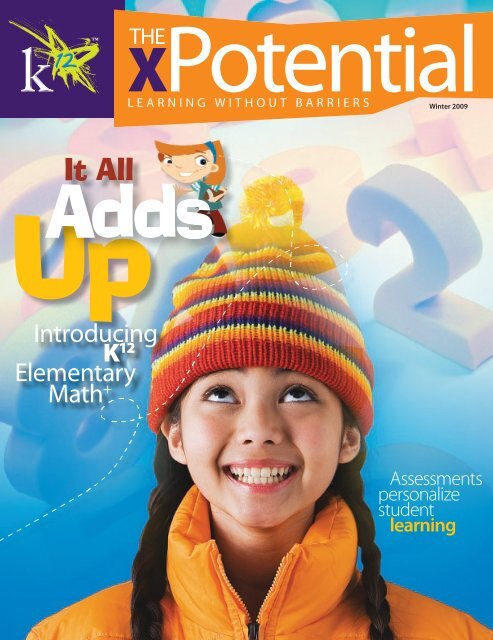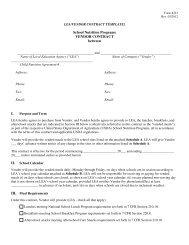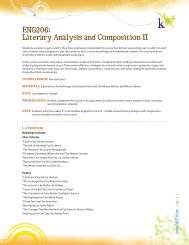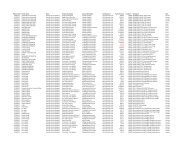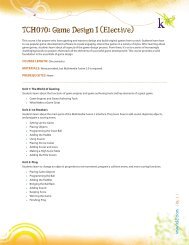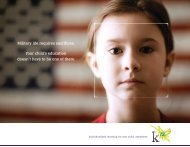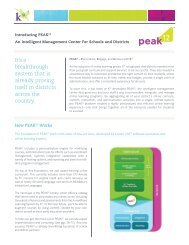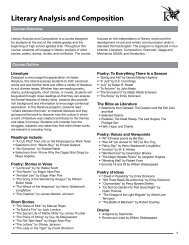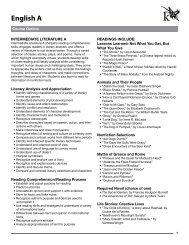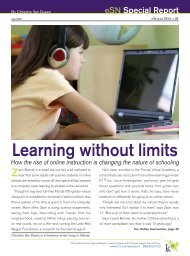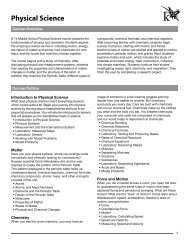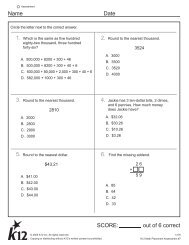It All Adds Up - K12.com
It All Adds Up - K12.com
It All Adds Up - K12.com
You also want an ePaper? Increase the reach of your titles
YUMPU automatically turns print PDFs into web optimized ePapers that Google loves.
<strong>It</strong> <strong>All</strong><strong>Up</strong>IntroducingK 12ElementaryMath +XPotentialTHELE AR N I N G W I T H O U T BAR R I ER SWinter 2009<strong>Adds</strong>Assessmentspersonalizestudentlearning
From the Mind of BrorIs My Child LearningToo Slowly?By Bror Saxberg, K 12 chief learning officerAS THE NEW YEAR BEGINS, I AM THINKING ABOUT MANY OFyou in midyear, trying to figure out how you’re doing.I am reminded of a mom who talked with me at an Expo last spring. She hadbrought her middle school son along with her, a shy lad with a smile under a backwardturnedbaseball cap, with baggy jeans and hands stuffed deep in his pockets.After letting me know how things were going, she paused. She then rushed outthe question she had been waiting to ask me, with her son at her side: “My son is agood kid—works really hard, studies hard, spends the time. But he takes a long timeto really get it—he has to work so hard to get there,” she said. “Should we be worried?Is this still OK?”Her unspoken question: “Am I doing the right thing for my son, seeing howhard it is for him, now?”I looked at the boy, and from under his cap, he smiled nervously: “Yes, sir, it takes me a while toget there, but I do get there,” he said.I looked at the mom and the boy, and thought about the cognitive science I knew—aboutexpertise, and how it requires practice, lots of practice. About the evidence that later expertise isonly lightly related to early promise, but hugely related to work and practice over an extended periodof time. Simply put, it’s not so much where you start, but how much you’re willing to work.And I was able to tell the mom, “Don’t you worry. As long as your son is mastering what he’s setout to master, his experience being confused and figuring it out, over and over again, will make himone of the most valuable people anyone could ever work with.”Think about it—whom do we value most around us at work or to do work? Those who “get itdone”—those who reliably “figure it out,” whom we can trust not to let things slip, but to sort outcomplex problems none of us have seen before, without panic.So don’t spare your kids from being challenged by the K 12 program. Support them. Help them,yes, but let them learn what it feels like to be challenged with academics, perhaps a bit confused,and then overcome this—over and over again.<strong>It</strong>’s a gift for your children that will change a lifetime!Happy New Year!THINKSTOCK IMAGES/JUPITER IMAGES2
2300 Corporate Park DriveHerndon, Virginia 20171www.<strong>K12.com</strong>xPotential\ ek-spә-’ten(t)-shә-l \ n (2007)1: the innate “possibility factor”unique to every child < hardwork and the right educationcan unlock and completelydevelop a child’s ~ >2: LIFE PROMISE; LIFEPOSSIBILITY 3: the personal,visceral and intellectualzenith that a child can reachby immersing herself in thepassionate combinationof cognitive science,individualized learningapproaches, and rich,engaging content found inthe K 12 curriculum.We want to hearfrom you!E-mail feedback andarticle ideas toxPotentialstories@<strong>K12.com</strong>Table ofContentsWinter 2009From the Mind of Bror | p 2Is my child learning too slowly?K 12 Closeups | p 4Meet the Likness and McClintock familiesThoughts on Learning | p 6What history can teach usCount on <strong>It</strong> | p 7Introducing K 12 Elementary Math +Tailor-Made | p 10New assessments personalize learningfor every studentClass Acts | p 12K 12 educators Theresa Bruns and Victoria Hortonpractice empowered educationNews & Notes | p 14Highlights from K 12 ’s virtualpublic schoolsGet Connected | p 16Connect with fellow families traveling the K 12 roadEditorial and Design ManagementCopyright © 2009. <strong>All</strong> rights reserved. K 12® , asregistered in the U.S. Patent and Trademark Office,and the K 12 logo and design are trademarks andservice marks of Web Names, Inc., and are used byK 12 Inc., pursuant to a license. Unleash The xPotentialis a trademark and service mark of K 12 Inc.COVER: STEVE ALLEN/JUPITER IMAGES; TERRY VINE/JUPITER IMAGESTHIS PAGE: INMAGINE/JUPITER IMAGES3
K 12 CloseupsThe LiknessFamilyCHEF’S DELIGHT4Home:Woodstock, Ga.School:Georgia Virtual AcademyPets:2 dogs, 2 catsFavorite Dinner:Marinated New York stripsteak with roasted redpotatoesFavorite Family Movie:ElfFavorite Book:(tie) Little House on thePrairie series and NancyDrew series<strong>It</strong> is a Thursday morning,and 8-year-old Alyssa “LizzieMarie” Likness is busy in thekitchen of her family’s Woodstock,Ga., home, cooking up herlatest goodies made with fresh andhealthy ingredients. With the helpof her parents, Lizzie has transformedher interest in cooking into a promisingLizzie Marie, 8; Doreen & Jeremyenterprise, Lizzie Marie Cuisine.Since 2006, the business has blossomed fromsales at a summer farmers market to her own Web site featuringLizzie’s cooking demonstrations, kids’ cooking classes at a local community center, and appearanceson local television stations and at the annual Taste of Atlanta, alongside other well-known localand national chefs.“I love cooking, and I have a passion for other things, too, like horseback riding. I really like drawingfashions,” says the young entrepreneur and “chief culinary officer.” “One of those things I wouldlove to do when I grow up, but right now my top priority is to be a chef,” says Lizzie.Education is another priority for the Likness family. Mom Doreen homeschooled Lizzie whenthe family moved to Georgia in 2006. When the state opened the Georgia Virtual Academy (GVA),Doreen immediately enrolled her daughter, thinking it would provide Lizzie the flexibility she neededto continue to run her business while being continually challenged at school.“GVA allows a student to move ahead in the grade levels once they’ve mastered the current curriculum,”Doreen explains. “On the flip side, those families who have a student who needs to spendmore time to master the curriculum, they can do it at their own pace.”A fourth-grade student, Lizzie excels at language arts, studies history, and enjoys math and science.Lizzie likes to focus on one subject every day and cover three to four lessons at a time. On one day,for example, Lizzie might read stories and then answer questions to show her reading comprehension;on another, she might tackle two- and three-digit multiplication lessons.The skills Lizzie cultivates through her business also translate into school credit. “A lot of timeswhen she’s doing a business event, that counts toward a health lesson because she’s teaching peoplehow to identify what healthy foods are and what to do with them,” Doreen says. Cooking lessons alsooffer lessons in math and science, such as multiplication and division required for doubling or halvingrecipes, or the chemical reactions that occur when active baking ingredients combine.Sometimes the business is a source of simpler life lessons, such as how to price baked goods basedon the cost of the ingredients. Lizzie also accompanied her parents to the bank to open up a businessbanking account. “She got to learn how to write a check and fill out a deposit slip,” Doreen says.Now in her second year with GVA, Lizzie has become more mature and independent with herstudies, Doreen says, and she’s enjoying more online Elluminate sessions with her teacher, DianeSmoke, and with other GVA students. Lizzie also meets other GVA students in person throughschool field trips and Girl Scout activities. “Socially, she has such a busy calendar,” Doreen says. “Justbecause we school at home doesn’t mean she’s in a bubble.”
The McClintockFamilyLOVING LIFENothing stops 10-year-old ElisabethMcClintock from enjoying life—not her tiny62-pound frame, not the medications and treatmentsshe must undergo daily, and not her cysticfibrosis (CF).“I like to study animals and plants,” saysElisabeth, an outgoing, self-described tomboy. “Iwant to be a veterinarian when I grow up.”Mom Deborah always enjoyed homeschoolingher three children—Abigail, 16, Andrew, 13,and Elisabeth—but she wanted to give them amore challenging curriculum. So, five years ago,she enrolled her older children in the ArkansasVirtual Academy (ARVA).“I also wanted more accountability,” Deborahexplains. “The K 12 curriculum pushes reading,math, and especially English. The homeschoolingcurriculum I was using would skip diagrammingsentences,” for instance. The K 12 curriculumstarts sentence diagramming in second orthird grade.For Elisabeth, a fifth-grader, her medicalcondition makes virtual learning even morevaluable.CF is an inherited chronic disease that affectsthe lung and digestive systems in about 30,000adults and children in the United States. <strong>It</strong> commonlyleads to life-threatening lung infections.“The virtual academy gives us the flexibilityto work with her many doctors” at severalappointments each month, says Deborah.“Whenever Elisabeth has a lung flare-up, shecould be hospitalized for weeks. Last year, shewas in the hospital for 18 days. <strong>It</strong>’s just easier forme to access her lessons right from the computerat the hospital. <strong>It</strong>’s great to be able to do that.”Now in her third year with ARVA, Elisabethwakes up every morning at 7:30 a.m., so that hermom can remove the night feeding tube. Sheeats breakfast and takes a round of medicines,followed by 30 to 40 minutes of lung treatment.During their morning ritual, Deborahand Elisabeth review the lesson plans to beHeyDid You Know?A microgram is one-millionth of a gram.accomplished that day. Then Elisabeth does herschoolwork until lunchtime, then chores andplay before finishing her schoolwork for theday—usually by 3:30 p.m.Other days are less than typical. On a recentMonday, Elisabeth spent six hours at the hospitalparticipating in a new phase-three drug study,alongside 140 other CF patients. “We took allher school books with us to the hospital, and shedid her schoolwork in between all the doctorsand nurses coming in. The flexibility is great tobe able to do that,” Deborah says.Back home, ARVA administrators makeit easy for Elisabeth to visit regular schoolsfor state testing and other functions given herspecial needs. “She needs to be tested in a smallgroupsetting, she needs to be allowed to bring asnack, she needs to have hand sanitizer and notbe near a sick child,” Deborah explains. To makesure those needs were met, ARVA held an onlineElluminate session with Deborah. In one hour,they drafted a special-needs plan for Elisabeth.Medical circumstances aside, Deborah saysshe prefers ARVA over bricks-andmortarschools because of theindividualized attention thatparents and virtual schoolteachers can provide.“You know what yourchild’s strengths andweaknesses arewithout having towait for a reportcard,” she says.“Every day, youhave the feedbackto knowwhat your childneeds to workon. You can’tbeat that when itcomes to educatingyour child.”Home:North Little Rock, Ark.School:Arkansas Virtual Academy (ARVA)Pets:2 dogs, 2 catsFavorite Dinner:TacosFavorite Family Movie:(tie) High School Musical and Nightat the MuseumFavorite Book:Old YellerElisabeth, 10;Andrew, 13; Abigail,16; Deborah &Timothy5
Thoughts on LearningDéjà Vu and theFuture, TooWhat history can teach usBy John Holdren, K 12’ s senior vice president for content and curriculumOne of my jobs at K 12 is to edit other people’swriting. Recently, I received a batch oftext to edit. The article features a discussionof “a widespread economic collapse”and describes how people raced to assignblame for the problem. The text pointsout that the blamers “overlooked a criticalcause—the overextension of borrowingand investment that had drawn so manypeople into the crisis.”What is this text I’m editing—a reporton our recent subprime mortgage crisisand multibillion-dollar bailout? The wordscertainly fit. News reports refer all toooften to “the overextension of borrowingand investment” or some close variation onthat theme.But the text I’m editing is not aboutour nation’s present-day economic woes.Rather, it’s from a book in progress forK 12 ’s high school U.S. History course. Inparticular, it’s about the Panicof 1819, the first majordownturn in whatwould prove to bean ongoing economic cycle of boom andbust in American history.When I came across the passage about“a widespread economic collapse” broughton by “the overextension of borrowing andinvestment,” I had that disconcerting feelingof “déjà vu all over again.” Indeed, as Icontinue to edit this U.S. History book, Ikeep coming across accounts of past eventsthat seem like they could have been liftedfrom this morning’s newspaper.Our country, for example, recently wentthrough a long presidential campaign thatincluded some negative campaigning onboth sides. <strong>It</strong>’s little consolation to knowthat negative campaigning has a long traditionin American politics, starting prettymuch after George Washington left office.During the 1828 campaign between JohnQuincy Adams and Andrew Jackson,Adams’ supporters accused Jackson ofbigamy, while Jackson’s supporters accusedAdams of furnishing the White Housewith “royal extravagances,” such as a massivebilliard table, at taxpayers’ expense.As I edit this U.S. History book andexperience frequent little shocks of recognition,two well-worn phrasescome to mind: (1) Those whodon’t know the past arecondemned to repeatit, and (2) historyrepeats itself.Those two familiar propositions do notnecessarily lead to the conclusion that historyrepeats itself simply because too fewpeople know the past. Even if studentseverywhere acquired Ph.D.-level knowledgeof history before graduating high school, wecould confidently expect that mankind—complex and flawed creatures that weare—would continue to repeat old errorsand destructive patterns. Unfortunately, thestatement “Those who don’t know the pastare condemned to repeat it” is not matchedby a counterpart, “Those who understandthe past can predict the future.”Knowing the past will not prevent usfrom repeating it—students of history willcontinue to experience sensations of déjàvu. But in challenging times like our own,knowledge of history can help us understandthe nature of current problems andchallenges.Although we may feel that the challengesfacing us are unique to this timeand place, often we find that others havefaced similar obstacles before. Knowledgeof history can shed light on current predicaments.Students, citizens, and politicalleaders can all benefit from knowing whathas been tried, what has been possible,what has failed—and what has succeeded.TOOGA/GETTY IMAGES6
countonitIntroducingK12ElementaryMath+STEVE ALLEN/JUPITER IMAGES; THINKSTOCK IMAGES/JUPITER IMAGES; TERRY VINE/JUPITER IMAGES12 t K, we pride ourselves on providing our students—your kids—Awith the best possible learning opportunities.That’s why we are developing Elementary Math + , K 12 ’s first-ever mathprogram designed from the ground up.Built for kindergarten through fifth-grade students, our latest offering7
8takes the same research-based approach that has proved sosuccessful with our other curricular programs and applies it tomathematics instruction.The new program is a combination of online and offlineactivities, manipulatives, parent and teacher guides, assessments,and other research-based learning materials. <strong>It</strong> melds the latestcognitive science with the individualized instruction K12 familiescount on to help their students achieve content mastery.But it’s more than just our proven approach that sets ElementaryMath + apart. Students will find the program appealingbecause it engages them in new ways.serenaronA Partner inMathAt K 12 , we’re big believers in the maxim “encouragement foreffort brings success.” Parents and teachers are an importantcog in any child’s support network. But students alsoneed encouraging voices to which they can relate. That’s whywe’ve created seven animated characters, or learning partners,designed to accompany each student through our math lessons.There’s Rosa, a Hispanic-American, who likesto play dress-up. She plays piano and guitar andloves to sing. Ron is an entrepreneur from LosAngeles who enjoys sports and has a pet frog.Bror is a real whiz at science, although prettychallenged by mathematics. Serena loves Sudokupuzzles and can calculate almost anything in herhead. Alexander is a wordsmith with a flair forgardening. Johnny is an animal lover and historybuff. And Winnie is a fast-talking tomboy fromDenver, a real “You can do it; try harder” type.Each character has his or her own personalityand cultural background. The charactersage alongside the student, becomingolder—and even a bit wiser—aslearners move through theprogram.brorNewLookand FeelWhether your student is new or a veteranof the K 12 approach, he or she will experiencelearning math as never before. Anarray of bright colors, animated designs,and learning paths customized for studentslend Elementary Math+ its signature appeal.Whether your student is learning measurementthrough a series of printed manipulativesor exploring place value and basic problemsolving by way of one of our many animated onlineadventures, each lesson brims with the kind of energyand excitement that promises to keep your student’smind humming.Customized learning paths provide the “plus” inElementary Math+ . The new program is adaptive, which
means that it changes to meet your student’s academic needs.Through a series of brief, on-the-spot assessments, the programgauges students’ mastery of important math conceptsand prerequisites and helps ensure they have what they need tomove forward.How We AreBuilding <strong>It</strong>Like everything at K 12 , Elementary Math + is rooted inresearch—lots of it.Before a single Elementary Math + lesson was designed, K 12 ’steam of educational experts pored over the latest and greatestcognitive science research to determine the most effectiveapproach to teaching elementary mathematics.“We knew there was enough research and work waitingto be put to use to make a difference,” says K 12 Chief LearningOfficer Bror Saxberg. K 12 ’s original math program pulledmaterials consistent with research from a variety of sourcesand textbook publishers—and it worked well, he says. But K 12 ’seducators and developers believed they could build an evenstronger program fromscratch.That belief wasreinforced in March2008 when theU.S. Department ofEducation’s NationalMathematics AdvisoryPanel, a commission ofthe nation’s brightestminds in mathematicsresearch and instruction,released its muchanticipatedreportdetailing the mostimportant elements ofeffective math instruction.In addition tospecific summaries ofeffective research, thepanel concluded effectivecurriculum needs to balance fluencyin operations and algorithms, conceptualunderstanding, and extensive experience,applying both to problems of all sorts.The entire Elementary Math + program is predicated onbringing these principles alive. Research, though, is just onepart of a much larger educational equation. Unlike traditionaltextbook programs or fully online instructional models,Elementary Math + integrates a diverse combination of printandcomputer-based materials together with a common designand research sensibility, striking a happy balance that reachesstudents no matter their learning style.To ensure success wherever students are located, importantstate and national learning standards are kept in mind. Andcontinuity throughout the different grade levels provides for aseamless transition from level to level, or what we like to call“stepping stones” to content mastery.Elementary Math + combines what is best about our work:engaging multimedia, coordinated online and offline components,and the most recent cognitive science research—allin a single, simple-to-use learning package that delivers theimportant skills needed to succeed.As your partner in learning, K 12 is always thinking aboutyour student’s future and how to leverage the latest technologyand science to get them there.Count on it!9
Tailor-New assessments personalize learningMadefor every studentThey say a picture is worth a thousandwords. At K 12 , we’ve been working to createa new kind of picture—one worth muchmore than that.Imagine a camera that would allow youto take a snapshot of your student’s academicprogress, similar to how a well-timedphotograph captures a memory, right downto the smile on your child’s face. That niftycamera then would allow you to create a personalizedlearning plan tailored specificallyto your student’s academic needs. <strong>It</strong> mightsound too good to be true. But that’s exactlythe kind of ability K 12 provides teachers andlearning coaches through its latest batch ofstudent assessments from Scantron.We know what you’re thinking: moretests? We already do online assessments; studentsalready participate in mandatory stateexams—do we really need more tests?We’re glad you asked. K 12 is committedto providing the best possible educationalexperience for your child, and that’s preciselywhat these new assessments help us to do.The first component of our assessmentpackage features the Scantron PerformanceSeries. A pair of assessments given once inthe fall and once in the spring, the PerformanceSeries helps us measure academicgains throughout the year.These so-called adaptive assessmentsadjust to each student’s knowledge level, givingteachers and learning coaches an accurateacademic snapshot of their academic understandingrelative to their grade level.Here’s how it works: By prescribing theassessment twice during the course of theschool year, K 12 is able to gauge students’ individualunderstanding coming into and exiting10a particular grade. Every student takes a different academic path,which makes this approach perfect for measuring how far your childhas come. (For more on K 12 ’s adaptive testing, see sidebar on page 11.)The second part of our assessment package is the ScantronAchievement Series. These brief, on-the-spot assessments (each onetakes about 30 minutes) are used to determine students’ mastery ofimportant state content standards.Parents today often groan at the notion of standards. That’s understandable.After all, such discussions typically segue into debates overmandatory state testing—and a certain “teach-to-the-test” philosophy,the very approach so many of our families have sought to avoid.At K 12 , we don’t teach to the test; we teach to the individual.Still, it is important for all students to master these standards.K 12 schools are public charter schools and, as a result, are held to thesame—if not higher—academic standards as their bricks-and-mortarcounterparts. No parent wants their child to do poorly on these tests.We want our students to be prepared, to walk into these tests feelingconfident, and to leave knowing they performed well.Why We Do <strong>It</strong>At K 12 , we firmly believe that every student is capable of makingtremendous gains; we also believe every student should have a clearlydefined path for growth over the course of the school year. Theseassessments help us chart that path.K 12 Senior Director of Academic Services Jennifer Sims puts it thisway: “Scantron is a tool; it’s not a test. These assessments inform usabout a student’s level of achievement so that we can make good decisionsabout moving that student forward in a way that is customizedto their particular learning needs.”The idea: to help teachers further tailor instruction to the needsof their students. Says Sims, “These tools provide us with very highlyindividualized information right at the beginning of the school yearso that immediately, from the minute those results are available, teachersand the parents can work together to make sure that their student’slikely strengths and weaknesses are addressed.”On a broader scale, the information K 12 collects from each assessmenthelps us evaluate the quality of our instruction and effectivenessof our overall approach to teaching and learning. We’ve got more than40,000 students within various K 12 learning environments across theDORLING KINDERSLEY/GETTY IMAGES; JESSICA MILLER/JUPITER IMAGES
country. The information we collectfrom each student goes a long wayin helping us understand whichparts of those environments areclicking and which parts need morework. Everything from teacher conferencesto Elluminate sessions toindividual student and group learningactivities are informed—and,we hope, bettered—by the results.Setting the RecordStraight—and MakingTimeFolks have a tendency to confuseassessment with high-stakes testing.K 12 wants to be clear thatour assessments are nothigh-stakes tests.They are usedsimply tohelpparents and teachers better meet students’ individualneeds and are not a determining factor ina child’s success or grade-level advancement.We understand, of course, that these assessmentstake time. As K 12 families, we know howmuch you value the flexibility that comes withour curriculum. That’s why we’ve made it possiblefor students to take these assessments whenand where it’s most convenient for them. Eachassessment is delivered online, and studentseven are able to take breaks and come back totest items in the event that their schedules don’tallow them to complete an entire assessmentin one sitting. We want these assessments tobecome an integrated part of the total learningexperience, and not something that is viewed asan addition to other requirements.Here at K 12 , it all boils down to one thing:creating a better kind of education,one student at a time.Adaptive Testing?What’s That?The Scantron Performance SeriesAssessment—the pre- and post-test yourstudent is asked to take once in the falland once in the spring—is what’s morecommonly referred to as an adaptivetest. What does that mean exactly? Inshort, adaptive tests are designed tohelp us measure academic growthover time. The word “adaptive”means each question a studentreceives depends upon his or heranswer to the question or questionsdirectly before it. Each test adaptsto the individual student’s level ofunderstanding. This is importantbecause it helps us quickly gaugewhere students are on the learningcurve in both math and languagearts. The results, in turn, helpteachers and learning coachesadjust their approach to theneeds of the student.Some Tips:• Resist the urge to helpyour student. Each test isdependent upon an accurateread of your child’s individualunderstanding.• Remember, these testsadapt to your student’s levelof understanding. The morethey know, the harder thequestions are likely to be.• More advanced studentstypically take longerto complete Scantronadaptive assessments thefirst time. If they knowa lot about a topic, thesystem needs to ask alot more questions tofind their true level ofunderstanding.11
Class ActsEmpoweredEducation¿Hablas Español?How language opens up the brain12Theresa’s Bookshelf:• We Were the Mulvaneysby Joyce Carol Oates• The Secret Life of Beesby Sue Monk Kidd• The Atonement Childby Francine Rivers• A Map of the Worldby Jane HamiltonHeyOhio Virtual Academy teacher Theresa Brunsknows that self-motivated students master alanguage more easily than others. And when youhave a Spanish-language teacher such as Bruns,who is excited about the K 12 program, that’s aone-two combination for success.Bruns, who has taught K 12 high school Spanishfor four years, “fell in love” with the program whenshe and her husband enrolled their three childrenin K 12 .“I wanted to be home with the kids, and we feltthat the K 12 program was the best out there,” shesays. A public-school Spanish teacher for 22 years,Bruns decided four years ago to join the K 12 teachingranks. Today, she teaches high school SpanishI, II, and III, as well as the Advanced Placement(AP) course. Bruns launched the AP program afterDid You Know?The Mona Lisa was painted over a three-year periodbetween 1503 and 1506.Theresa Bruns canattest to the manybenefits studentsgain by studyinglanguage.coming on board at K 12 andsays she is proud that the seven AP studentsshe has taught for the past four years are poised tograduate and go on to college.Like all K 12 teachers, Bruns says one of the manybenefits of the school is the connection betweenteachers, students, and parents. “When I started, Ididn’t know how well I would get to know my students.But then I found that I quickly got to knowthem all pretty well,” she says, adding, “When I talkto parents, I can truly say that I understand whatthey are going through, because I can personallyrelate to their experience.”¡HOLA!Mastering a language requires interaction withothers. <strong>It</strong>’s the continued practice of dialogue thathelps students grasp dialect and the subtleties oftone and nuance. Bruns says the K 12 program combinesa rich, immersive, interactive language cur-THINKSTOCK IMAGES/JUPITER IMAGES
THINKSTOCK IMAGES/JUPITER IMAGESriculum with “real-world” experiences.Whether students learn a language in a traditionalclassroom or a virtual setting, Bruns says,“They still ask the same questions or don’t ‘get’ thesame things.” The difference is that many K 12 studentsdo not have daily contact with other studentsin a bricks-and-mortar setting. That’s why theyneed to go the extra step and seek out daily contactto practice conversation.“We have weekly audio assignments, and thestudents speak Spanish when they come to myclass,” explains Bruns, adding, “We’ll get togetherand go to lunch or dinner to a Spanish restaurantand practice. I have students who tell me that theyseek out Spanish-speaking people in their neighborhoodsto practice conversation.”Throughout her teaching career, Bruns has foundthat students who study a language perform betterin other subjects, too. “<strong>It</strong>’s amazing how learning alanguage opens up their brains. They do better inother subjects, and it also makes them more culturallyaware,” she says.Paradigm ShiftEducation that makes a differenceWebster’s New Millennium Dictionary defines “paradigmshift” as a “fundamental change in approachor assumptions.” Victoria Horton, regional programcoordinator for California Virtual Academies(CAVA) uses that same term to describe a K 12education.“Traditional education is a one-way approach,but that’s like saying there is only one way to getfrom California to New York,” says Horton. “Manystudents today have different agendas that don’twork in a rigid traditional school setting. Nowthere are choices—more educational paths to getwhere they need to go.”Horton says one of the most interesting aspectsof her job is discovering that every family has differentreasons for choosing a K 12 education.“Fundamentally, it’s about empowerment.Maybe students weren’t getting their needs met ata traditional school,” she says. “Not everybody fitsinto a box…kids have so many wonderful dreamsand hopes. Now they have choices about their educationand can set their own path.”As CAVA regional program coordinator, Horton’sjob is akin to an assistant principal. “Every dayis unique, but my first priority, ultimately, is supportingfamilies, and I do that by working with teachersand administrators—collaborating to make sureour families’ needs are being met,” she says.A K 12 staff member for four years,Horton started as a lead teacher and forthe past two years has served in her currentposition, where she is responsiblefor K 12 ’s Los Angeles region—servingsome 2,000 students and 80 teachers.Horton describes her job as fun,because she gets to work with families,teachers, regional teachers, andadministrators. “Every day is a littlebit different,” she says. “The dailyinteraction and collaboration thatgoes on is all about supporting thefamilies—parents may not see itbecause it’s behind the scenes, butthat’s our first priority,” she says.An advocate of virtual education,Horton knows firsthand howa nontraditional education canmake a positive difference in afamily. As a former teacher in LaPuente, Calif., where the majorityof residents are Hispanic and20 percent fall below the povertyline, Horton recalls the struggles of teaching.“About 70 percent of the students were Englishlearners, and the priorities were on the basics,but the kids were so hungry for enrichment andresources,” she recalls. “And then during one of ourK 12 open house events for prospective students, afamily from La Puente attended, and I got chillsbecause I knew that our amazing, enriched curriculumwould change their lives”—the true definitionof a paradigm shift.Victoria’s Bookshelf:Favorite nonfiction:• John Adamsby David McCulloughFavorite fiction:• My Antoniaby Willa CatherVictoria Hortonsees the bigpicture of virtualeducation.13
News & NotesWASHINGTON VIRTUAL ACADEMIESWAVA students are reaping the rewards from teachers’ recent online Elluminate trainingsessions. K 12 ’s Guadalupe VanDerPloeg spent three days training teachers about thebenefits of using Elluminate as a teaching tool for K–12 students. WAVA extends itscongratulations to two teachers for earning their National Board Certificates! Joy Roth andKaren Knowles are just two of the exceptional teachers working with WAVA students. InDecember, WAVA held several Winterland of Gingerbread events across the state. Familiesdesigned, built, and showcased gingerbread houses as part of a gingerbread villagedisplayed at local ice-skating rinks. In an effort to give back to the community, students alsohave set a lofty goal of collecting 2,008 canned goods to be distributed by local food banksthroughout the state.NEVADA VIRTUAL ACADEMYNVVA families across the state recently joined in some school fun andoutings to celebrate the changing of the seasons. Events includedschool pictures, fall festivals, gingerbread events, and book clubs. NVVAalso made preparations for geography and spelling bees as well asstatewide science fairs. <strong>It</strong>’s been a busy season indeed for NVVA, packedwith fun, lots of learning, and a bit of state testing, too.14CALIFORNIA VIRTUAL ACADEMIESCAVA has experienced dynamic growthand recently introduced two new heads ofschool. Katrina Abston is CAVA’s southernregion head of schools, which includes schoolschartered in San Diego, Los Angeles, Kern, andKings counties. Pam Jonidis is head of schoolsfor CAVA’s northern region, which includesschools chartered in Jamestown, San Joaquin,San Mateo, Sonoma, and Sutter County. CAVAcontinues to offer statewide events for currentCAVA families and those interested in learningmore about CAVA. CAVA’s Java Socials arealways a big hit; parents enjoy connecting withother CAVA parents to share ideas, strategies,and stories. With spring 2009 just around thecorner, CAVA is busily planning several OpenHouses, where families will be invited to gettogether within their local communities andparticipate in social activities. CAVA staff alsolook forward to hosting a series of Demo Dayslater this spring.HeyDid You Know?The Nancy Drew Files series of books started in 1986.ARIZONA VIRTUAL ACADEMYThroughout the holiday season, AZVA hostedseveral hot cocoa gatherings for families toconnect, chat, play games, and learn about theschool. But the brightest event of the seasontook place in Yuma, where one of AZVA’steachers, Jena Kugel, coordinated a serviceproject, giving her students the chance toprepare holiday gift baskets for families inneed. One of Kugel’s seventh-grade studentswas so excited about the project that heinvited a local newspaper reporter to attendthe event. The reporter later published anarticle in the Yuma Sun.
MINNESOTA VIRTUAL ACADEMYMNVA enjoyed an awesome start to the2008–2009 academic year! As the first semesterof the first year of MNVA High School comesto a close, it’s encouraging to look back andsee how much has been accomplished in sucha short time. The year kicked off with severalMeet-and-Greet social events, including tripsto local museums, apple orchards, and bowlingalleys. MNVA High School established its firstschoolwide volunteering club, MNVA’s HelpingHands, and is in the process of creating more.MNVA High School held a series of Open Houseand Ice-Cream Social events in December anda schoolwide orientation at a local water parkin January. MNVA’s K–8 students have beenbusy attending community-building events,including an Open House at the zoo, children’stheater performances, book clubs, workshops,and more.AGORA CYBER CHARTER SCHOOLStudents in Agora Cyber Charter School areheaded for a Grand Slam school year. They ledoff the first inning by attending orientationsheld by teachers through online Elluminatesessions in the early weeks of school. Bighits came later with Back to School Picnicsat community and state parks throughoutPennsylvania. At each picnic, students showedtheir school pride by leaving an artistic printon a regional banner. Those banners areproudly displayed in our main office. Duringeach picnic, teachers led student activities,while parents were provided an opportunityto make their own connections by sharing tips,tricks, and stories. The hits, no doubt, will keepcoming in the second half of the school year.OHIO VIRTUAL ACADEMYOHVA’s fall online and in-person events were well-attended and fun forall who participated. Back to School Picnics, Fall Festivals, New ParentConnection sessions, Meet-and-Greets, Ice-Cream Socials, a special SteveIrwin Week online session from the Australia Zoo, Family Fun Days, andmore brought students and families together in a variety of settings.And winter promises still more activities, including Barnes & NobleBook Fairs, Spelling Bees, a Geography Bee, and Learning and ScienceFairs. Plus, OHVA’s Parent Training Academy and its Parent SteeringCommittee are on hand and available to help see families through thewinter. Join OHVA’s newly created Booster Club to let others know aboutOHVA and become an active member of the school community! Visitwww.k12.com/BoosterProgram/ohva for more information.GEORGIA VIRTUAL ACADEMYGVA is gearing up for another great year! GVA students just wrapped up a series of fun outingsdesigned to teach them about nature, zoo animals, and Georgia Civil War history. Many studentsalso recently visited local science museums to gain perspective and experience with hands-onexperiments. GVA students proudly celebrated with fellow student Zach Bonner on his 30-daywalk to end homelessness for children! The Cares Club team built a red wagon and collecteddonations to further the cause. GVA also recently hosted several Reading Mornings across thestate. The events aimed to help students build confidence in reading out loud. GVA is workingwith parents to help families develop skills in writing and math. The school also is holding aseries of Ice-Cream Socials and preparing for a trip to Washington, D.C., for the presidentialinauguration.15
Get ConnectedGet Connected—There’s no need for you and your child to go it alone—connectwith fellow families who are traveling the K12 road!ThebigthinK12 — Th e 12 K Community Chest is transitioning into thebigthinK 12 . Th i sunique online community is the new place to experience Bror’s Blog, join our expertspeaker series, connect to other families on the K12 journey, and more.K 12Speaker Series—Join experienced K 12 parents online to learn more about how tomake the award-winning K12 curriculum work for you and your family. These sessionsuse Elluminate Live!, a Web-based meeting tool, so you don’t even need to leave hometo attend!Things to Look Forward To—The xPotential, our quarterly newsletter, is filled with arti-cles from our education experts, news about upcoming K12 events and contests, and hintsand tips to help make your education experience with K12 the best it can be!Contests and Competitions—We like to give our students the chance to show off theirtalents, so we sponsor nationwide art contests, writing competitions, and more throughoutthe year.E-mails and Other Communication—We send periodic postcards and e-mails to keepyou apprised of special offers, new courses, events, and lots more! And you can always optout if you don’t want to receive e-mails from us.We’re delighted to have you in the K12 family. <strong>It</strong>’s our goal to help all students dis-cover what they have inside themselves, and to help them unleash their xPotential!DAVID JORDAN WILLIAMS/JUPITER IMAGES; DBIMAGE/JUPITER IMAGESHeyDid You Know?HeyDid You Know?Joseph Strauss designed the Golden Gate Bridge.Presorted StandardU.S. PostagePAIDLebanon Junction, KYPermit #6152300 Corporate Park DriveHerndon, VA 20171www.<strong>K12.com</strong>


